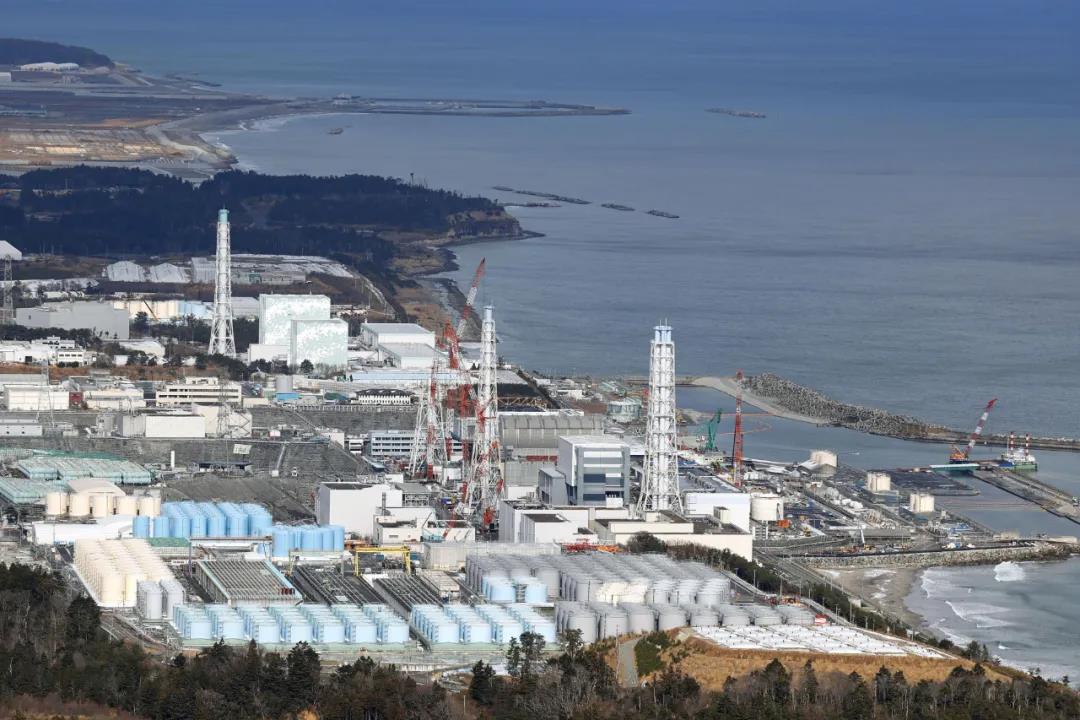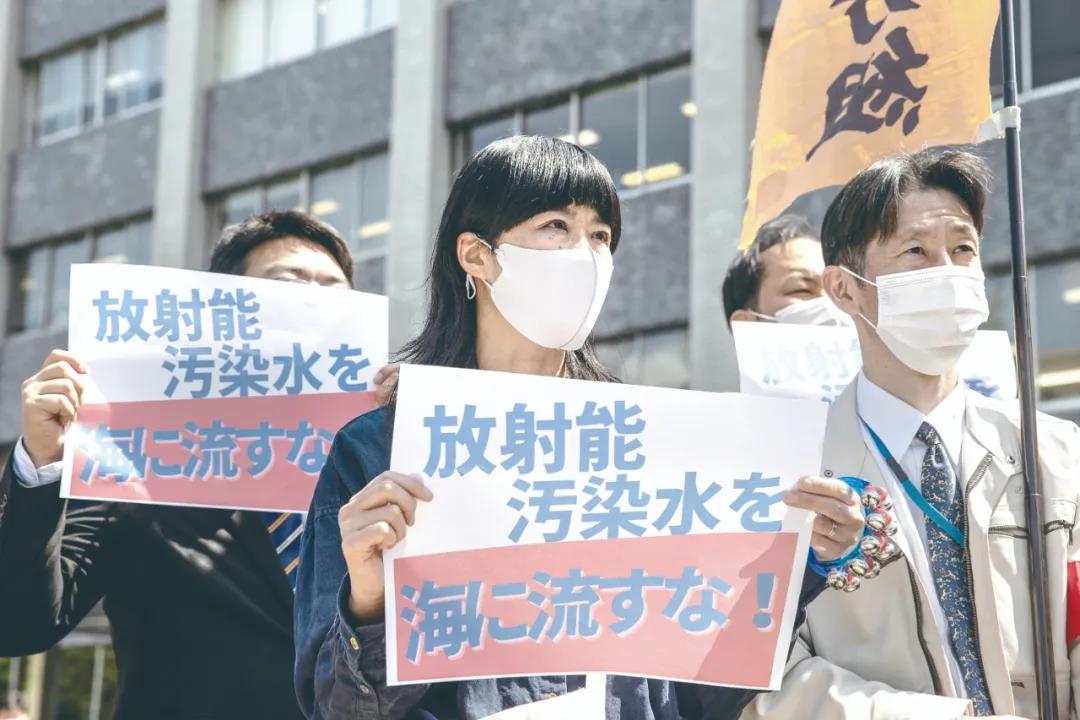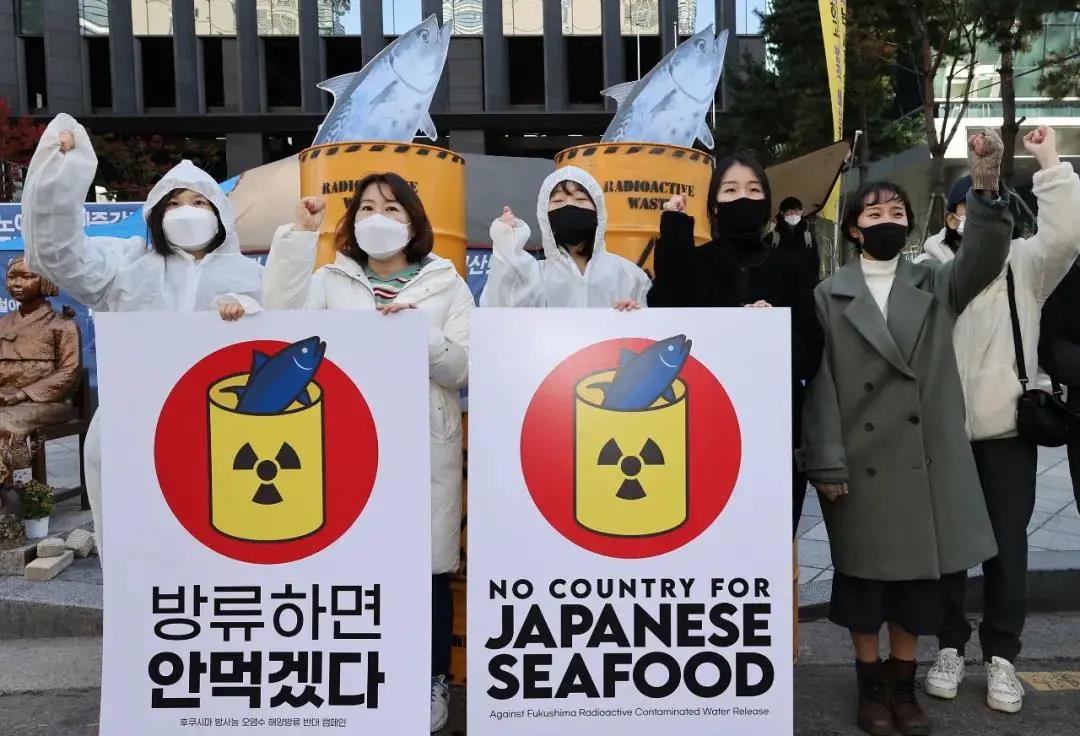日本福岛核废水让全世界买单 怎么办
- 2021-04-13 16:15:44
- 点赞量:4468
- 点击量:71072
- 作者:秘书处Secretary's Office

图片2011年3月11日,日本福岛第一核电站发生灾难性辐射泄漏,用于冷却核反应堆的辐射污水预计明年秋天达到储量极限。(资料图/图自人民视觉)
百万吨核废水,将被倾倒向太平洋。
日本政府4月13日早上召开相关阁僚会议,正式决定向海洋排放福岛第一核电站含有对海洋环境有害的核废水。
有研究显示,核废水排放后,只需要57天,放射性物质将扩散至半个太平洋——世界上最大、最深、边缘海和岛屿最多的大洋。
日本福岛核事故造成放射性物质泄漏,对海洋环境、食品安全和人类健康产生了深远的影响。“排污入海”显然不仅仅是日本国内的问题,更是影响全球海洋生态和环境安全的国际问题。
核废水储水罐将满,日本政府决定向大海排放符合“标准”的核废水
十年来,大量无法处理的核废水,一直是悬在日本上空的“达摩克利斯之剑”。
2011年3月11日,日本东北太平洋地区发生里氏9级地震,继而引发海啸。由东京电力公司运营的福岛第一核电站因海水灌入发生断电,其4个核反应堆中有3个先后发生爆炸和堆芯熔毁,造成灾难性核泄漏。
这场事故等级被定为核事故最高分级7级(特大事故)。至今,福岛核电站周围仍然无法正常住人。
核废水处理,是福岛核事故善后处理中的一个重大难题。为了控制核反应堆的温度,东京电力朝反应堆内注入了大量冷却水。反应堆内的冷却水再加上雨水与地下水日复一日地涌入,核电站内源源不断地产生越来越多带有辐射物质的核废水。
日本媒体分析称,日本政府决定排出核废水,原因可能是福岛第一核电站储存核废水的储存罐容量即将达到上限。
当前,东京电力公司采用“边截流边治理”的方式处理核废水问题,一边在核电机组厂房周边设置地下汲水井,用截流的方式减少地下水流入,一边使用多核素去除设备用于清除核废水中的放射性物质。由于现有技术无法有效去除核废水中具有放射性的氚,含氚污染水被存储在大型储水罐内。
据日本媒体报道,现在每天新增的核废水约为140吨。东京电力共准备了约1000个储水罐,总容量约为137万吨,目前9成已装满,所储存的处理过的废水超过120万吨,预计2022年秋季达到极限。
今年2月,日本政府负责处理核废水问题的相关委员会发表了一份报告,列出了“海洋排放”和“水蒸气”两种方案处理核废水。该报告宣称海洋排放“更加切实可行”,按照日方说法,氚排入海中对人类健康影响“相对较小”。
真的只剩下向海洋排放一条路了吗?日本“核能市民委员会”曾指出,“大型储存罐在陆地上保管”或“用灰浆凝固处理”是现有技术下解决核废水问题的最佳方式,可以确保核废水在陆地上妥善保管。
“虽然在福岛第一核电站内无空间新建储存设施,但在核电站周边许多因辐射浓度超标且无法居住的空地上,完全可以新建储存设施。”中国海洋大学教授、中国海洋大学海洋发展研究院高级研究员金永明认为。
此前也有日本媒体指出,福岛第一核电站周边有大量因辐射量过高而不宜居住的区域,这些闲置土地完全可以用来新建存储设施。
不过,从成本效益考虑,日本政府认为最好的方法是经稀释后向大海排放符合“标准”的核废水。毕竟,把核废水往大海里“一倒了之”,显然比建设更多储水罐省事、快捷,还省钱,眼不见心不烦。
福岛核电站核废水处理事故不断,背后是人为的灾难
在日本政府向国际社会公开倾倒核废水的决定之前,福岛核电站的核废水已经数次“闯祸”。
2011年4月,东京电力公司就曾将内含低浓度放射性物质的1.15万吨污水排入大海。对此,时任内阁官房长官的枝野幸男辩解称,排放污水是“实在没办法的事”,但这“不会立即对邻国产生辐射污染”。
2013年8月,日本福岛核电站发生严重泄漏。据日本媒体报道,核厂储存槽泄漏出约300吨高度污染的核辐射水,“可能已经流入海洋”。这是核灾危机发生以来的最严重的辐射废水外泄事件,日本原子能规制委员会将该问题升至国际核能事件分级表第3级“严重事件”。
2013年10月,含有放射性物质的废水从福岛第一核电站蓄水罐群周围的多处防漏围堰内溢出。经检测,从核电站港湾外连接外海的排水沟中采集的水样中,锶等释放β射线的放射性物质,最高辐射值每升的辐射强度已经高达14万贝克勒尔。这是有史以来此处检测到的辐射强度的最高值。
2014年4月14日,东京电力公司宣布,福岛第一核电站再次发生泄漏事故。高浓度核废水被误送至其他厂房,约200吨核废水泄漏至地下室,原因是平时不使用的水泵被打开。该公司称,泄漏的是冷却反应堆后产生的高浓度废水,由于处于清除铯等放射性物质之前的阶段,每升废水中含有数千万贝克勒尔的放射性铯。

日本政府将福岛第一核电站的核污水排入大海的决定遭到包括福岛民众、日本渔民乃至国际社会的谴责和质疑。图为当地时间4月11日,日本东京民众自发举行集会,打出反对含氚废水排入海洋、海洋在哭泣等标语,希望日本政府不要单方面的强行决定。(图片来源:人民视觉)
每一次事故发生后,东京电力公司相关负责人都进行了“诚恳的道歉”,但并没有解决实际问题。
福岛第一核电站核泄漏事故发生后,东京电力公司曾表示,海啸是无法提前预料的。然而,来自政府和独立调查机构的报告,都将福岛第一核电站事故描述为人为的灾难,是安全疏忽、监管机构疏于监督和相互勾结的结果。
据日本媒体报道,早在2008年日本国内就有独立调查机构分析福岛第一核电站所在地有可能遭遇7级以上大地震和10米级海啸的冲袭,但是当时东电公司却以“并未感到有采取应对措施的需要”低调处理,而这份预警报告则是拖延到2011年3月7日才递交到日本核安全机构手里。
正是由于日本消极应对此次核事故,才使得事态持续升级并迅速失去控制。而福岛核事故善后不力,日本政府难辞其咎。为避免东京电力公司破产,日本政府虽然对其采取了实质上的国有化,却没有在核事故处理上负起应有的国家职责,而是任由信用破产的东京电力继续将福岛核电站变成一个“信息黑洞”。
日本原子能规制委员会一名委员在考察核废水泄漏问题时发现,东京电力甚至没有记录核废水储存槽周边辐射量的变化。换句话说,核事故发生以来,日本政府和东京电力制定的应对方案实际上已破绽百出。
更令人惊讶的是,据共同社报道,福岛第一核电站内保管废弃物和瓦砾等的集装箱中,无法把握箱内所装物品详情的,约有4000个。报道称,福岛第一核电站厂区内,今年3月在放置集装箱的区域地表发现了辐射量较大的凝胶状块形物,有可能是从被腐蚀的集装箱外泄的。
核废水不仅对人类具有潜在的毒性,还能以更持久和更复杂的方式影响海洋环境
有日本学者指出,福岛周边的海洋不仅是当地渔民赖以生存的渔场,也是太平洋乃至全球海洋的一部分,核废水排入海洋会影响到全球鱼类迁徙、远洋渔业、人类健康、生态安全等方方面面。
引起恐慌的核废水,究竟有何可怕之处?
所谓核废水,是在冷却核反应堆后残留的废水。根据日本专家的研究,核废水中的主要污染物是氚等多种放射性物质,它们各自的半衰期有所不同。氚的半衰期约为12.43年,铯-137的半衰期是30年,锶-90半衰期29年,它们的危害都不是短时间内能消除的。
为了安抚国际社会,日本政府正极力宣传排放的安全性。东京电力公司称,绝大部分放射性物质经精密的过滤程序后都可以清除,在核废水入海前,还会进行二次处理,把废水里氚的浓度稀释到日本国家标准的四十分之一。东京电力一名负责人甚至在采访中声称,这些核废水即使每天喝下去2升,也不会对身体健康造成损害。
然而,根据“绿色和平组织”去年10月发布的报告,福岛核废水中含有的大量氚和碳-14,将大幅增加人类集体接收的辐射剂量,存在损害人类DNA的潜在危险。用该组织高级核专家肖恩·伯尼的话说,废水中的有害元素和其他放射性核废料将危害环境达几千年之久。
此外,这些放射性物质很容易进入海洋沉积物,被海洋生物吸收。它们不仅对人类具有潜在的毒性,还能以更持久和更复杂的方式影响海洋环境。

韩国民众抵制日本海产品 图源:环球时报
在无数生命栖身着的太平洋面前,日方所谓“对人体无害”的说辞显得无比单薄。
太平洋的生物是世界各大洋中最为丰富的,生物量占世界大洋的50%以上。太平洋动物种类为其他大洋的3至4倍,仅印度尼西亚各群岛海域就已知有2000多种鱼类,热带太平洋软体动物门区系超过6000种,石珊瑚类超过2000种。
俄罗斯科学院远东分院太平洋海洋研究所实验室首席科研员、生物学博士弗拉基米尔·拉科夫指出,“各项标准都没有充足的依据,对于某人而言,所谓的浓度就是标准;但对其他人而言,则是其他指标。生物体是不相同的。也许,这合乎人的标准,但对章鱼呢?显然不是。又比如,对鲸而言,只需相当少的剂量就能让它们死亡。对于数百万种海洋生物的标准并未制定。”
此外,拉科夫表示,这些核废水即使经过净化,如果被排到海洋中,仍可能导致放射性同位素留存在包括鱼类在内的海洋生物体内、继而在人体内积累。
浩瀚的海洋的确可以稀释放射物剂量,但人类历史上从未有过将总量可观且具有较长半衰期的各类放射性物质释放进入全球水循环系统的先例。诸多科学家与环保组织均表示,由于核废水的巨大体量和现有技术的有限,无法完全预知排放的废水将给海洋环境和人类安全造成什么潜在伤害。
“诚然,日本政府曾多次强调向海洋排放的核废水符合相应标准,并获得国际原子能机构的认可,但日本国内外至今依然反对将核废水排入海洋,主要原因就在于核污染影响的深远且未知。”《日本新华侨报》总编辑、北京大学历史系客座研究员蒋丰表示。
蒋丰指出,发生于上世纪50年代的“水俣病事件”,是因为日本氮化肥公司1925年开始向水中排放未经处理的废水,但直到1956年水俣病患者才开始大量出现,并对海洋生态环境造成严重污染。最初人们以为是排入海洋中的氮造成的影响,但最后通过调查研究发现罪魁祸首是汞。
“因此,日本政府今时今日向海洋排放符合‘标准’的核废水,但又有谁能保证未来不会发生类似的‘水俣病事件’呢?而且,当年的‘水俣病事件’主要集中于日本部分区域,但排放入海洋的核废水将会蔓延至整个太平洋,其造成的影响必将更为严重且深远。”蒋丰说。
把因自身疏忽产生的灾难性结果转嫁到海洋当中,是极端不负责任,也是极端短视的行为
2021年3月,东日本大地震10周年之际,日本首相菅义伟赴福岛县视察。他表示,“核废水的储存罐不断增加,存放场地愈发紧张,在这种状况下我们不应该总是推迟做决定,将在恰当的时候负责任地做出决策。”
向太平洋倾倒核废水,就是负责任的决策吗?
日本政府的这一决定,在日本国内外遭到广泛反对。根据民调,约有50%的国民反对政府这一决定。日本全国渔业协同组合联合会明确反对将核废水排入海洋,福岛民众在多地发起示威抗议,举起“海洋在哭泣”、“反对含氚废水排入海洋”等标语牌,反对日本政府的相关计划,希望政府不要单方面强行决定。
韩国外交部发言人崔泳杉在4月8日的记者会上表示,“迄今为止,我们一再强调日本政府需公开信息,遵守国际社会可接受的环境标准,以及进行客观透明的检查。”此前,韩国水产业协同组合中央会会长任俊泽曾会晤日本驻韩国大使馆参赞长井真人,反对日方将核废水排入大海的设想。韩国济州道知事元喜龙也敦促日本政府提供信息和展开磋商。
4月12日,中国外交部发言人赵立坚就日本拟决定核废水排海事答记者问,他表示,中方已通过外交渠道向日方表明严重关切,要求日方切实以负责任的态度,审慎对待福岛核电站核废水处置问题。
中国政法大学国际法学院教授霍政欣表示,国际社会迄今为止,将核废水排入海洋这一做法史无前例。霍政欣认为,根据《联合国海洋法公约》,日本政府如果将核废水排入海洋,将构成典型的海洋环境污染行为,不仅有违于国际道义,也应承担相应的国际法责任。该公约明确规定了各国有保护海洋环境的义务和责任。日本也有义务保护和保全海洋环境,采取一切必要措施,防止、减少和控制海洋环境污染。
对于如此严重的问题,西方国家及其媒体却陷入了沉默。损害全球自然环境、对包括人类在内的众多生物造成深远伤害的行为,被热衷于炒作“人权”、“环保”议题的西方媒体选择性地集体忽略,更显讽刺。
1956年加入联合国至今,日本一直将自身定位为一个“负责任的大国”,如今却要将本国的核废水倾倒入太平洋,“辐射”到周边国家乃至国际社会的公共福祉和利益。把因自身疏忽产生的灾难性结果转嫁到海洋当中,是极端不负责任,也是极端短视的行为。
环球同此凉热,把核废水排向太平洋的责任,日本承担不起。
英文直译
English literal translation
Millions of tons of nuclear waste water will be dumped into the Pacific Ocean.
On the morning of April 13, the Japanese government held a relevant cabinet meeting and officially decided to discharge the nuclear waste water from the Fukushima Daiichi nuclear power plant, which is harmful to the marine environment.
Studies have shown that only 57 days after the discharge of nuclear waste water, radioactive materials will spread to half of the Pacific Ocean - the largest, deepest, marginal sea and ocean with the largest number of islands in the world.
The Fukushima nuclear accident in Japan caused the leakage of radioactive materials, which had a profound impact on the marine environment, food safety and human health. "Sewage discharge into the sea" is obviously not only a domestic problem in Japan, but also an international problem affecting the global marine ecology and environmental security.
The nuclear waste water storage tank will be full, and the Japanese government has decided to discharge the nuclear waste water meeting the "standard" into the sea
For ten years, a large number of untreated nuclear wastewater has been the sword of Damocles hanging over Japan.
On March 11, 2011, an earthquake with a magnitude of 9 on the Richter scale occurred in the northeast Pacific region of Japan, which triggered a tsunami. The Fukushima Daiichi nuclear power plant operated by Tokyo Electric Power Company was cut off due to seawater flooding. Three of its four nuclear reactors exploded and the core melted down successively, resulting in catastrophic nuclear leakage.
The accident level is rated as the highest level of nuclear accident level 7 (major accident). So far, people are still unable to live around Fukushima nuclear power plant.
Nuclear wastewater treatment is a major problem in the nuclear accident treatment in Fukushima. To control the temperature of the reactor, Tokyo Electric Power injected a lot of cooling water into the reactor. The cooling water in the reactor, coupled with the inflow of rainwater and groundwater day after day, the internal sources of nuclear power plant constantly produce more and more nuclear wastewater with radioactive substances.
Japanese media analysis said the Japanese government decided to discharge nuclear waste water, possibly because the Fukushima Daiichi nuclear power plant storage capacity of nuclear waste water is about to reach the maximum.
Photo: on March 11, 2011, the first nuclear power plant in Fukushima, Japan, suffered a catastrophic radiation leak, and the radioactive sewage used to cool the nuclear reactor is expected to reach the reserve limit next fall. (data map / map from people's vision)
At present, Tokyo Electric Power Company adopts the method of "intercepting while treating" to treat the nuclear waste water. On the one hand, underground water pumping wells are set around the nuclear power plant to reduce the inflow of groundwater by intercepting, and on the other hand, multi nuclide removal equipment is used to remove radioactive substances in the nuclear waste water. Because the existing technology can not effectively remove the radioactive tritium from the nuclear waste water, the tritium contaminated water is stored in the large water storage tank.
According to Japanese media, the amount of nuclear waste water added every day is about 140 tons. Tokyo Electric Power has prepared about 1000 water storage tanks with a total capacity of about 1.37 million tons. At present, 90% of them are full, and the treated wastewater stored exceeds 1.2 million tons, which is expected to reach the limit in the autumn of 2022.
In February this year, the relevant committee of the Japanese government responsible for the treatment of nuclear waste water issued a report, which listed two options for the treatment of nuclear waste water, namely "marine discharge" and "water vapor". The report claims that marine emissions are "more feasible", and according to Japan, tritium emissions into the sea have "relatively small impact" on human health.
Is there really only one way to the ocean? Japan's nuclear energy civil Commission has pointed out that "large storage tanks are kept on land" or "treated by mortar solidification" are the best ways to solve the problem of nuclear waste water under the existing technology, which can ensure the proper storage of nuclear waste water on land.
"Although there is no space for new storage facilities in Fukushima No.1 nuclear power plant, it is possible to build new storage facilities on many open spaces around the nuclear power plant which are beyond the radiation concentration and cannot be inhabited." Jin Yongming, a professor at the University of China and a senior researcher at the Institute of marine development, China Ocean University, believes.
Previously, Japanese media pointed out that there are a large number of areas around Fukushima Daiichi nuclear power plant, which are not suitable for living due to excessive radiation, and these idle land can be used for new storage facilities.
However, in terms of cost-effectiveness, the Japanese government believes that the best way to do so is to dilute and discharge "standard" nuclear waste water to the sea. After all, it is obvious that it is easier and faster to pour nuclear waste water into the sea than to build more water storage tanks, and also save money. It is not bothering to see the eyes.
The nuclear wastewater treatment accidents of Fukushima nuclear power plant are constantly, and behind them are human disasters
Before the Japanese government made a decision to dump nuclear waste water publicly to the international community, Fukushima nuclear power plant nuclear wastewater had "broken down" several times.
In April, 2011, Tokyo Electric Power Company once discharged 11500 tons of sewage containing low concentration radioactive substances into the sea. In response, then chief cabinet chief Yukio zhinoma argued that sewage discharge is "really impossible", but this "will not immediately produce radiation pollution to neighboring countries.".
In August 2013, Japan Fukushima nuclear power plant suffered a serious leakage. According to Japanese media, about 300 tons of highly polluted nuclear radiation water "may have flowed into the ocean" from the nuclear plant storage tank. This is the most serious radiation waste water leakage event since the nuclear disaster crisis. The Japan Atomic Energy Regulatory Commission has raised the problem to level 3 "serious event" in the international nuclear energy event classification table.
In October 2013, the wastewater containing radioactive substances overflowed from multiple leak proof cofferdams around the storage tank group of Fukushima No.1 nuclear power plant. Through testing, strontium and other radioactive substances released β - rays from water samples collected from the drainage ditch connected to the outer sea outside the nuclear power station bay have reached 1400000 Becquerel with the highest radiation value per liter. This is the highest radiation intensity ever detected here.
On April 14, 2014, Tokyo Electric Power Company announced that Fukushima No. 1 nuclear power plant had another leakage accident. High concentration nuclear wastewater was misdirected to other plants, and about 200 tons of nuclear wastewater leaked to the basement, because pumps that were not used in ordinary times were opened. The company said the leak was high concentration wastewater from the reactor after cooling, which contained tens of millions of Becquerels of radioactive cesium per liter, as it was in the pre phase of removing radioactive substances such as cesium.
picture
The decision of the Japanese government to discharge nuclear sewage from Fukushima Daiichi nuclear power plant into the sea was condemned and questioned by the people of Fukushima, Japanese fishermen and the international community. The picture shows that on April 11, Japanese people held a spontaneous meeting to put forward signs against the discharge of tritium containing wastewater into the ocean and crying in the ocean. I hope that the Japanese government will not unilaterally make a decision. (source: People's vision)
After each accident, the relevant head of Tokyo Electric Power Company made "sincere apology", but did not solve the actual problems.
Tokyo Electric Power Company said the tsunami was unpredictable after the Fukushima Daiichi nuclear power plant nuclear spill. However, reports from the government and independent investigation agencies describe Fukushima Daiichi nuclear power plant as human-made disasters, which are the result of safety negligence, oversight and collusion between regulators.
According to Japanese media reports, as early as 2008, there were independent investigation agencies in Japan to analyze that the location of Fukushima No.1 nuclear power plant was likely to be hit by a magnitude 7 earthquake or a 10 meter tsunami. However, at that time, Dongdian company handled it with a low-key "need for no response measures", and the early warning report was submitted to Japan nuclear safety agency until March 7, 2011 In your hand.
It was Japan's negative response to the nuclear accident that made the situation continue to escalate and quickly out of control. The Japanese government is responsible for the failure to deal with the aftermath of the Fukushima nuclear accident. In order to avoid the bankruptcy of TEPCO, although the Japanese government has taken the substantial nationalization of TEPCO, it has not taken the due national responsibility in dealing with the nuclear accident, but let the credit bankrupt TEPCO continue to turn the Fukushima nuclear power plant into an "information black hole".
A member of the Japan Atomic Energy Regulatory Commission, while examining the leakage of nuclear waste water, found that Tokyo Electric Power did not even record the changes in radiation around the nuclear waste water storage tank. In other words, since the nuclear accident, the Japanese government and Tokyo Electric Power have actually broken out of their response.
What's more surprising is that, according to Kyodo, there are about 4000 containers in Fukushima Daiichi nuclear power plant that are unable to grasp the details of the items contained in the container. Reported that in the Fukushima Daiichi nuclear power plant area, in March this year, a large amount of gelatinous block was found on the surface of the container area, probably from the corroded container.
Nuclear wastewater is not only potentially toxic to humans, but also affects the marine environment in a more lasting and more complex way
Some Japanese scholars pointed out that the sea around Fukushima is not only a fishing ground for local fishermen, but also a part of the Pacific Ocean and even the global ocean. The discharge of nuclear waste water into the sea will affect the global fish migration, pelagic fishery, human health, ecological security and other aspects.
What is the horror of the nuclear waste water that caused panic?
Nuclear wastewater is the residual waste water after cooling the nuclear reactor. According to the research of Japanese experts, the main pollutants in nuclear waste water are tritium and other radioactive substances, and their half-life is different. The half-life of tritium is about 12.43 years, the half-life of cesium-137 is 30 years, and strontium-90 half-life is 29 years. Their harm is not eliminated in a short time.
To appease the international community, the Japanese government is vigorously promoting the safety of emissions. Tokyo Electric Power Company said most radioactive substances can be removed after precise filtration procedures, and that before nuclear waste water enters the sea, it will also carry out secondary treatment, diluting the tritium concentration in the waste water to one-quarter of the national standard of Japan. Even if the water is drunk for 2 liters a day, it will not harm health, a person in charge of Tokyo Electric Power said in an interview.
However, according to a report released by Greenpeace last October, a large amount of tritium and carbon-14 in Fukushima nuclear waste water will significantly increase the radiation dose received by human beings, which is potentially dangerous to damage human DNA. In the words of Sean Bernie, a senior nuclear expert at the organization, harmful elements and other radioactive nuclear waste in wastewater will harm the environment for thousands of years.
In addition, these radioactive materials are easily accessible to marine sediments and absorbed by marine organisms. They are not only potentially toxic to humans, but also affect the marine environment in a more lasting and more complex way.
picture
Korean people resist Japanese Seafood source: Global Times
In front of the Pacific Ocean where countless lives live, the Japanese so-called "harmless to human body" is extremely thin.
The life of the Pacific Ocean is the most abundant in the oceans in the world, with the biomass accounting for more than 50% of the world's oceans. The species of Pacific animals are 3 to 4 times that of other oceans. More than 2000 kinds of fish are known in the islands of Indonesia alone. There are more than 6000 species of tropical Pacific molluscs and over 2000 species of corals.
Vladimir rakov, chief researcher of the laboratory of the Institute of Pacific oceanography, Far East Branch of the Russian Academy of Sciences and doctor of biology, pointed out that "there is no sufficient basis for each standard. For one person, the so-called concentration is the standard, but for others, it is other indicators. Organisms are different. Maybe it's human, but what about octopus? Obviously not. For whales, for example, they can be killed in a fairly small dose. There are no standards for millions of species of marine life. "
Moreover, rakov said that even if the nuclear waste water is purified, if discharged into the ocean, it may cause radioisotope to remain in marine organisms, including fish, and then accumulate in human body.
The vast ocean can release the radiation dose in a thin way, but there has never been a precedent in human history to release all kinds of radioactive materials with a considerable amount and a long half-life into the global water cycle system. Many scientists and environmental protection organizations have said that due to the huge volume of nuclear waste water and the limited existing technology, it is impossible to fully predict what potential harm the discharged waste water will cause to the marine environment and human safety.
"It is true that the Japanese government has repeatedly emphasized that the nuclear wastewater discharged to the sea meets the corresponding standards and has been recognized by the International Atomic Energy Agency. However, Japan still opposes the discharge of nuclear wastewater into the ocean at home and abroad, mainly because of the far-reaching and unknown effects of nuclear pollution." Jiang Feng, chief editor of Japan's Xinhua overseas Chinese daily and visiting researcher of Peking University's history department, said.
Jiang Feng pointed out that the "Minamata disease" incident occurred in the 1950s because Japan nitrogen fertilizer company began to discharge untreated wastewater into the water in 1925, but it was not until 1956 that the patients with Minamata disease began to appear in large quantities and caused serious pollution to the marine ecological environment. At first, people thought it was caused by nitrogen discharged into the ocean, but finally, through investigation and research, it was found that mercury was the main culprit.
"So, the Japanese government is now discharging" standard "nuclear waste water to the ocean today, but who can guarantee that similar" Minamata disease "will not happen in the future? Moreover, the Minamata disease event in that year mainly concentrated in some areas of Japan, but the nuclear wastewater discharged into the ocean will spread to the whole Pacific Ocean, and the impact will be more serious and far-reaching Jiang Feng said.
It is extremely irresponsible and short-sighted to transfer the disastrous consequences of one's own negligence to the sea
In March 2021, on the 10th anniversary of the great earthquake in East Japan, Japanese Prime Minister Naoto Kan Yi Wei visited Fukushima Prefecture. "The storage tanks for nuclear waste water are increasing and the storage space is becoming more and more tense, and in this case we should not always delay the decision, and we will make decisions responsibly at the right time," he said
Is dumping nuclear waste water into the Pacific a responsible decision?
The decision of the Japanese government has been widely opposed at home and abroad. According to the polls, about 50 per cent of the population opposed the government's decision. The National Federation of Japan fisheries cooperation and cooperation has clearly opposed the discharge of nuclear wastewater into the sea. Fukushima people have been protesting in many ways, raising signs such as "the sea is crying", "the tritium containing wastewater into the ocean", and the relevant plans of the Japanese government. It hopes that the government will not make unilateral decisions.
"So far, we have repeatedly stressed the need for the Japanese government to make public information, comply with environmental standards acceptable to the international community, and conduct objective and transparent inspections," South Korean Foreign Ministry spokesman Cui Yongshan said at a press conference on April 8 Previously, Ren Junze, President of the South Korean water industry coordination Association, met with Japanese Embassy counsellor hirohiti Yoshiko, against the Japanese idea of discharging nuclear waste water into the sea. South Korea's Jeju Dao governor yuan Xilong also urged the Japanese government to provide information and start consultations.
On April 12, Chinese Foreign Ministry spokesman zhaolijian answered a reporter on Japan's plans to decide on nuclear wastewater discharge. He said that China has expressed serious concern to Japan through diplomatic channels and asked Japan to treat nuclear wastewater treatment of Fukushima nuclear power plant with a conscientious and responsible attitude.
Huozhengxin, a professor at the International Law School of the University of political and law of China, said that the international community has so far unprecedented practice of discharging nuclear waste water into the sea. According to huozhengxin, according to the United Nations Convention on the law of the sea, if the Japanese government discharges nuclear wastewater into the sea, it will constitute a typical act of marine environmental pollution, which is not only against international morality, but also bear corresponding international law responsibilities. The Convention clearly stipulates that states have the obligations and responsibilities to protect the marine environment. Japan is also obliged to protect and preserve the marine environment and take all necessary measures to prevent, reduce and control marine environmental pollution.
For such a serious problem, western countries and their media have been silenced. The behavior of damaging the global natural environment and causing profound harm to many organisms including human beings has been neglected by Western media who are keen on the topics of "human rights" and "environmental protection", which is more ironic.
Since its accession to the United Nations in 1956, Japan has always made its own







0 条 评 论 Write a Response